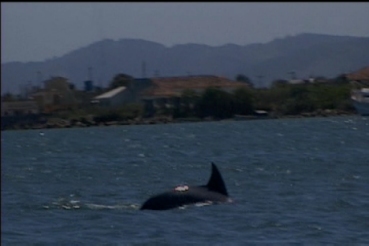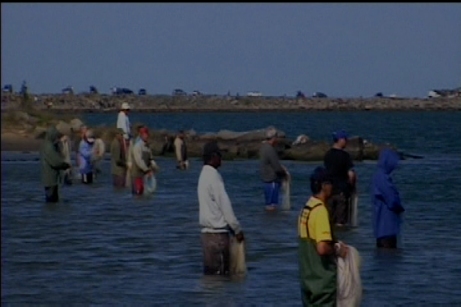
The Dolphins of Laguna
In Laguna, Brazil, bottlenose dolphins herd fish towards a line of fishermen, signal to them when to throw the net, and then dive to get some of the fish
Key words: Bottlenose, dolphin, Laguna, Santa Catarina, Brazil, cooperative fishing, mullet, throw net,

A Dolphin Requesting a Throw net
In collaboration with colleagues Arthur Schiefler, Prof. Dr. Geraldo Milioli, and Donna Nissani, I (Dr. Moti Nissani, Prof. emeritus, Department of Biology, Wayne State University) studied what Karen Pryor and colleagues refer to as "a dolphin-human fishing cooperative in Brazil." We were especially interested in this question: "Do the dolphins understand that they are giving a signal to the fishermen to cast the net, or have they acquired this unique signal through blind, mindless, years-long, trial and error learning?" We paid therefore particular attention to the fairly standardized and stereotypic signal given by these bottlenose dolphins. We do not know yet whether the dolphins understand their signaling action, but we plan to publish a detailed description and analysis of the signal itself.
We may also note in passing that this natural wonder is under severe threat, leading to at least two applications 1. If you find yourself in the Laguna area, it's well worth a visit. It's one of the most beautiful towns in Brazil, with great surfing and wonderful people--all these besides the signaling dolphins. 2. Maybe, if just enough people realize the grave threat (from pollution, overfishing, overpopulation, motor boats . . . ) to the remnants of this natural wonder, the dolphins, and the way of life of the traditional fishermen and hobbyists, can still be saved. It's almost Earth Day, 2008, when we're posting this, so maybe humanity, Brazil, the state of Santa Catarina, the cities of Tubar�o and Laguna, will still come to their senses and save this fabulous, incredibly beautiful and touching, dolphins and their odd way of sustaining themselves in a hostile world.

Fishermen of Laguna, patiently awaiting the Dolphins' arrival
This unique cooperation has been first formally studied by Karen Pryor and her colleagues: Pryor, K.W., Lindbergh, J., Lindbergh, S. & Milano, R. (1990) A dolphin-human fishing cooperative in Brazil. Marine Mammal Science 6:77--82. Here is how they described it:
"The fishing is highly ritualized and appears to involve learned behavior by both men and Dolphins. The fishermen, each with a circular nylon throw-net rimmed with weights, position themselves in a single line, a net's diameter apart, standing in approximately 1 m of water parallel to the shore. One or two dolphins station themselves several meters outside the line of men, facing seaward, floating or moving slowly at the surface. From time to time a dolphin submerges, usually in moving seaward; the men then brace themselves. The dolphin reappears, usually in a few seconds, traveling toward the line of men. It comes to an abrupt halt and dives just out of the net range, 5-7 from the line, thus making the surging roll at the surface, a movement markedly different from normal respiratory surfacings. Men who are in front of the dolphin as it rolls then cast their nets. Successful fishermen return to the beach to harvest their catch, and others replace them on the line. The men rarely cast without a dolphin's cue, and nets were not cast behind a dolphin, or in its general vicinity, or in front of dolphins that had not signaled, but only in front of dolphins performing the correct behavioral sequence indicating the arrival of fish. The cue is quite informative. Timing of roll: fish are present. Direction of dolphin's movement: Location of fish. Vigor of movement: appears to indicate whether the schools is large or small. Episodes which are successful for the fishermen are often followed by bouts of dolphins feeding. For the dolphins, this fishing method provides a reliable, easily located resource. The fishing appears to be initiated and controlled by the dolphinss, not by the men. On 4 occasions, when dolphins moved to another sections of the beach, immediately some or all of the men ran to reform a line in the new site selected by the dolphin. In other parts of the lagoon on several occasions we have seen one or more men waiting to shore in the hope of a dolphin's arrival. Fishing does not begin until a dolphin initiates it. Unlike other parts of the world, here dolphins do not play or socialize. 'At no time did we observe a fisherman call out, signal to, or in any way attempt to affect the behavior of a a dolphin. Fishermen never touch, train, give fish to, dolphins. 25-30 of the dolphins are said to participate in the cooperative fishery. Unlike other accounts, here in Laguna dolphins work individually, and they initiate and control the fishing. Here, as well, used with many prey species, almost year-round. Feeding specializations might be transmitted culturally within long-term associations of related individuals."
As will be described in detail elsewhere, this description beautifully captures the essence of the interaction. One possible minor error is, as can be seen in the video clips below, that no rolling action is involved. Overall, the action is extremely rapid, so that its details can only be caught and studied on film. On average, during the period that comprises the signal, the dolphin can be seen above water for just 1.4 seconds.

A dolphin signaling for a throw net
The Nature of the Signal
We have video recordings of complete, or partial, 68 signaling sequences, filmed on 11 different days, in the spring of 2006, from September 7 to November 5, in collaboration with colleagues Arthur Schiefler and Prof. Dr. Geraldo Milioli. Of these 68 signals, 54 were recorded in two adjacent, standing fishermen only, locations, on the Laguna side of the inlet. The other 14 were recorded in a more western location on the Laguna site, comprising 6-10 active standing fishermen on the eastern portion of the site joined to the west by two canoeists, all forming a single line.
The sequence typically begins with the rapid surfacing of the signaling dolphin (henceforth: start of signal). Of the 45 signals for which we have a video record of first sighting a would-be signaler, in 42 the first body part observed above water was the rostrum or rostrum and head, in one episode of breaking surface, the dorsal fin was seen first, and in two others, the entire body could be observed under the water prior to breaking surface.
In 53 of 55 of videorecorded cases, the surfacing was accompanied by a short, explosive, air exhalation. We were able to record the time lapse between first sighting of a signaling dolphin and visible start of exhalation in 41. In one of these cases, the exhalation started at the same time the dolphin first emerged. In the other 40, the exhalation took place after a brief delay (Mean: 0.16 seconds; range: 0.07-0.33).
Signaling dolphins reach maximum elevation of their head within 0.19 seconds of first becoming visible (N=33, range, 0.1-0.5 seconds), with the head at an average angle to the water of 28.8� (N=24, range 15�-35�). The fin is typically first seen in 0.3 seconds from the start (N=39, range; 0-0.77).
On average, the tip of the rostrum touches the water in 0.43s from the start of the sequence (N=33; range 0.17-0.83). The dorsal fin reaches its approximate highest position by 0.84s (N=48, range .53-1.5).
In 39 of 53 cases, the last part observed before the dolphin vanished below the surface of the water, the dorsal fin was seen last. In 8 additional cases, the tip of the dorsal fin and the midway portion of the dorsal part of the body, approximately midway between fin and fluke, were seen last at the same time. In 4 other cases, the fluke was seen last.
The average duration of any part of the body staying above water during the signaling sequence was 1.40s (N=56; range-0.93-2.50; standard deviation 0.3).
Of the 68 signals, 34 were directed seaward, roughly in an eastern direction, in 7 the head was directly facing the line (North), in 8 it was directed towards the line, but at an angle (roughly north-east or north-west), in 17, the movement was towards the right, away from the sea, in a right-hand angle to the left of the line of standing fishermen or mixed fishermen/canoeists. In one case it was directly away from the fishermen (South), and in still one other case, away at an angle (roughly SW).
A few videos
Bottlenose Dolphins in Laguna Requesting a Throw Net
Cooperative Dolphins of Laguna: 3 Successive Signals
Cooperating Dolphins of Laguna: The Signaling Aprentice
Cooperative Dolphins of Laguna: Leleco / Happy Fsherman
Cooperative Dolphins of Laguna: Data on Nature of Signal
Bottlenose Dolphin Requesting a Throw Net: Borracha
Cooperative Dolphins of Laguna: Botinha do Rio Jumping
Cooperative Dolphins of Laguna: The Dolphins are in Charge (One of the unique aspects of this dolphin/human collaboration is, as Karen Pryor and her colleagues noted, is that the dolphins determine the time and place of the interaction. As can be seen here, when the dolphins move, the fishermen follow.)
Cooperative Dolphins of Laguna: A Distant Perspective (Here is the way the dolphin/human fishing interaction is seen from a distance. Note the beauty of the setting, the number of fishermen, and the dolphin's signal).
Cooperative dolphins of Laguna: Signal of Caroba
Online References
1. Prof. Moti Nissani's presentation at the 2007 International Ethological Conference.
2.Sim�es-Lopes, Paulo C.; Fabi�n, Marta E.; Menegheti, Jo�o O. (1998). Dolphin interactions with the mullet artisanal fishing on southern Brazil: a qualitative and quantitative approach. Revista Brasileira de Zoologia, 15:709-726.